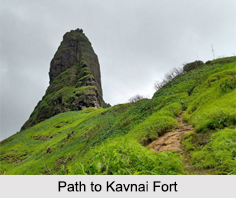 Located at Kavnai village in the Igatpuri region of Nashik district, the Kavnai Fort is one of the hill forts of Maharashtra. The only remaining structures standing today are the main gate and a small pond.
Located at Kavnai village in the Igatpuri region of Nashik district, the Kavnai Fort is one of the hill forts of Maharashtra. The only remaining structures standing today are the main gate and a small pond.
Overview of Kavnai Fort
The origin of the Kavnai Fort dates back to the time of the Mughal Dynasty. But eventually, the fort was turned into a stronghold of the Nizams of Hyderabad until it was captured by the British Indian army in the 19th century under the leadership of Colonel Briggs.
Currently in ruins and under the administration of the Government of India, the Kavnai Fort was built from stones. It is now a tourist destination and is easily accessible since the fort is connected to the base by a flight of rock- cut stairs. Tourists can trek their way to the fort as it usually takes an hour to reach the top.
Visiting Information on Kavnai Fort
The Nashik railway station is the closest at a distance of about 49 km and is easily accessible by roadways. And the closest airport to the Kavnai Fort is the Nashik Airport located at a distance of 45 km.
This article is a stub. You can enrich by adding more information to it. Send your Write Up to content@indianetzone.com.



















